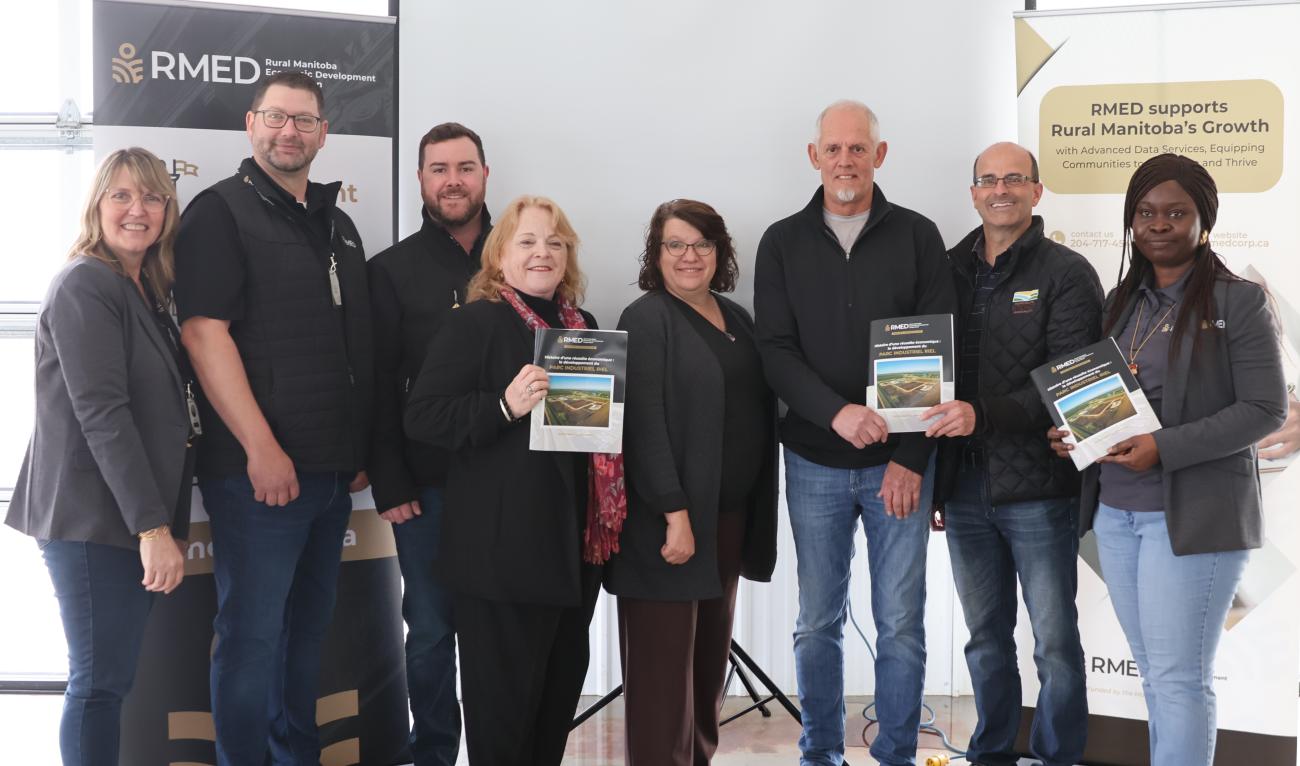Local stakeholders, politicians, and representatives of the Rural Manitoba Economic Development Corporation (RMED) gathered at Cheyenne Park in Ste. Agathe on May 16 to recognize the economic success story that is the Riel Industrial Park.
Margot Cathcart is president and CEO of RMED, an organization under the umbrella of the provincial government whose mandate is to support economic development projects in rural communities.
RMED has been a supporter of the Riel Park project since the organization was created in 2020.
“One of the things I like most about my job is being able to come out to community events like this and see the energy, the passion, and the vision that exists in them,” Cathcart said. “If we could get that all harnessed [across the province], we would be a serious force to contend with all around the globe.”
The Riel Industrial Park is located at the corner of Highways 305 and 75 and covers an area of 95 acres. The number of businesses here has een growing for the past 20 years, with an average of one or two lots being sold per year. Now in its third phase of development, only 11 lots remain. The park has been mortgage-free for two years.
A total of nine businesses have invested in the park to date, including anchor companies like Hemp Oil Canada and Flying J.
Before the park is completely sold out, RMED is seeing the value of what’s happening here and has created a full-colour 23-page case study to help other communities around the province model what Ste. Agathe is doing.
The reason that innovative solutions such as the Riel Industrial Park are so important, Cathcart said, is because they can change communities and the people who live in them.
“I just returned from visiting a community in Europe that has reversed their population decline, they’ve reversed their average age, and they’ve increased their average income over the last ten years.”
MLA Ron Schuler couldn’t help but echo Cathcart’s enthusiasm for the Riel Park project.
“This is a great place to invest in this community,” Schuler said. “You’re on the number one corridor for Canada to access the U.S… This corridor is incredibly important.”
Cathcart agreed. Not only is Ste. Agathe’s location on Highway 75 important, but its proximity to Winnipeg plays a role when it comes to attracting international businesses.
The Perimeter Highway, just ten minutes to the north, provides the needed east-west trade connectivity.
And having a city so close means having good access to the skilled workers which Winnipeg’s educational institutions turn out every year.
“I have been so privileged to be able to help promote [Riel Park] literally [around the globe] for the last few years,” Cathcart said. “It’s been one of the projects that we have featured when we go to one of the world’s largest real estate investment shows. You don’t need to be big to punch way above your weight class.”
Sean Crew is the acting president for the Ste. Agathe Community Development Inc. (CDI), a key player behind the creation and development of the park. He’s also the chairman of the park’s board.
Along with other community champions, he’s been involved in the CDI for the better part of 20 years. As a not-for-profit organization, the CDI has been able to fund a number of community projects from profits made through industrial park lot sales.
Among those are Cheyenne Park, the boat launch, walking trails, and enhanced community infrastructure.
“Money [from the park] comes into the CDI and goes right back into this community,” Crew told the crowd. “We’re all volunteers, so none of us are paid for our services. We do it for our community and for the opportunity to keep our kids here in Ste. Agathe.”
The success of the park, though, is not solely because of CDI volunteers, he adds. It’s also thanks to funding from all levels of government and organizations such as RMED.
Ritchot councillor Joel Lemoine also spoke at the Friday event. He says that the RM is currently talking to local farmers to determine the availability of more land surrounding Riel Park in the hopes of a future expansion.
“Job creation is key in what we’re seeing,” Lemoine says. “We’re luring workers not only from our own community but neighbouring communities [too]. Residential development is great. It brings in some tax dollars, but commercial and industrial brings in even more tax dollars.”
Even so, residential development must at least keep up so that workers filling local jobs have a place nearby to settle.
Cathcart says that adequate and affordable housing is a problem for many communities around the province. As a matter of fact, one of RMED’s first case studies was on the city of Steinbach and revolved around housing solutions. Now other communities are following suit based on the results of that study.
“We want to be able to do that over and over again, because we don’t need recreate the wheel,” she said. “There is incredible work being done across the entire province and this is an opportunity for us to not just highlight but brag about and showcase the great work that communities are doing. We don’t need to compete with each other. We’re stronger together.”
Ste. Agathe resident Guy Gagnon closed the formal part of the gathering with words of thanks to those who helped build the community.
“If it wasn’t for volunteers, and if it wasn’t for their leadership skills and initiative to put our community on the map, especially after the 1997 flood, we wouldn’t have what we see here today,” Gagnon said. “So folks like Sean, Joel, Jeanot Robert, and others who preceded as chairman of the CDI, need to be thanked by the whole community and communities surrounding our area.”


